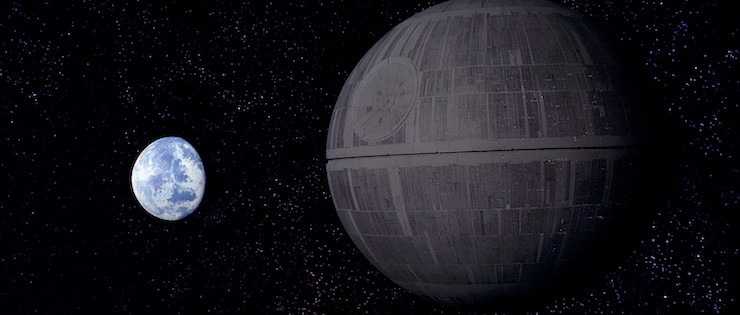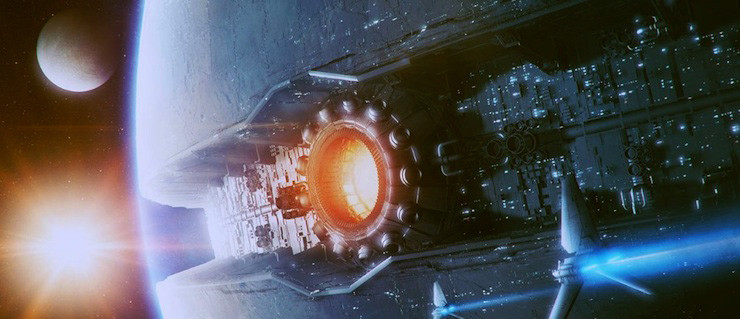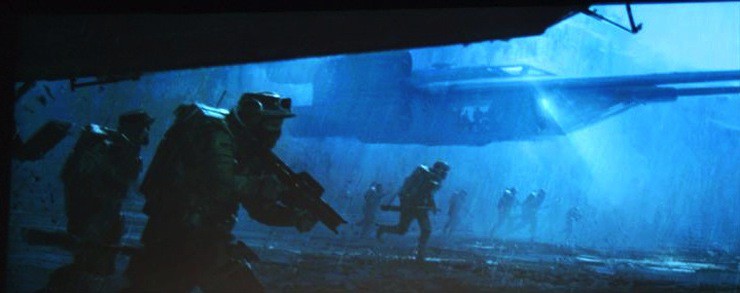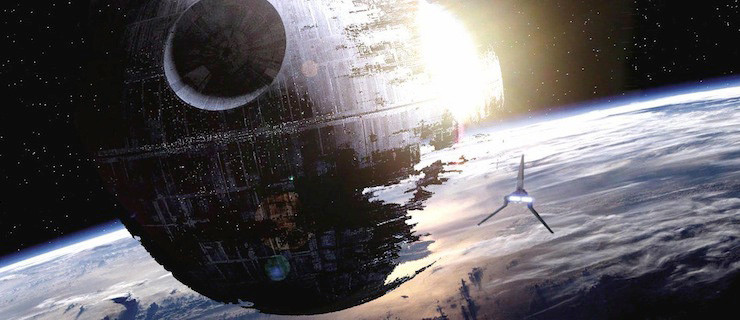With the release of the Rogue One trailer last week, we’re now officially into the “one Star Wars movie a year” release cycle. Early word is very promising too, and Gareth Edwards’ seems to have combined his ground level, character-centric approach with the Star Wars aesthetic to create something with a very different, yet familiar, flavour. Force 10 from Yavin IV, if you like.
But while the overall reaction has been positive, one of the minor criticisms I’ve seen raised is that this will be the fourth movie of an eight movie-and-counting series centred entirely around a Death Star. A New Hope is an entire script predicated on Chekov’s Battle Station, Return of the Jedi is much the same, and The Force Awakens got a lot of flak for its own version, Starkiller Base.
So, why go back there? Again?
In a word: history.
One of the things that the addition of the prequel trilogy did very successfully was provide context for the rise of the Empire. Those movies, along with the Clone Wars and Rebels cartoon series have done great work exploring the gradual ascent of Palpatine and the society’s subtle slide into dictatorship. There’s no switch that gets flicked, no sudden seizure of power beyond Order 66; Palpatine just slowly curdles popular opinion until he seems like the only choice. The first stage of his path to power ends with the slaughter of the Jedi. The second ends with the destruction of Alderaan.
This is the moment that the mailed fist of the Empire is revealed for all to see. Certainly in the lifetimes of the characters in A New Hope, a planet-killing weapon is unprecedented. Planets are occupied, wars fought, but the idea of simple, total obliteration of an entire world? That’s the moment the Emperor becomes a war criminal.

It’s also a perfectly timed show of force, with a small f. By revealing the Death Star’s existence the Emperor is also revealing his winning hand. He’s not taken control—he’s been GIVEN control, and the Death Star is his means of keeping it. He’s like the anti-Bond villain, revealing the truth after it’s far too late to do anything about it.
The first Death Star’s shadow falls on more than just Yavin IV. Its deployment sends a clear message to all the potential Rebels as well as the Alliance itself: we will find you. We will kill everyone around you to get to you. Surrender.
Just as importantly, it speaks to Palpatine’s arrogance. Not only does he want the largest weapon ever created, but he wants it to be used to literally and metaphorically reshape the galaxy. He is the final authority in what was the Republic, the arbiter of life and death. When viewed that way it could even be argued that this show of force is an act of revolt against the very thing that defines him. The Force may be everywhere, but Palpatine can remove big chunks of everywhere with one shot from the Death Star. Or at least he can, until it’s destroyed.
That’s why the second Death Star is so thematically powerful. Its very existence speaks to the Empire being on the back foot and temporarily outmaneuvered, returning to an old technique that almost worked as the Rebellion begins to gain momentum. Even the design of the station speaks to this, with its partially finished superstructure and the external shield generator protecting it. The Empire never learns why safety rails are a thing that happen, but give them credit: they made damn sure they closed that exhaust port.
If the first Death Star is the embodiment of Palpatine’s will, the second is the embodiment of his deviousness. The station’s fully operational central laser is a classic feint, the Empire on the ropes but far from powerless. The station also serves as the crucible for the multiple plots the movie, and Palpatine, have set in motion. It’s there that Luke is almost seduced to the Dark Side, and it’s there where the Emperor’s latest test of Vader’s loyalty fails, and there that the Empire finally begins to die. Again, it’s an immensely powerful image, both in-universe and as part of the movie: Palpatine dying in the half-completed remains of his ultimate weapon as the Dark Side’s greatest champion returns to the light. The Empire defeated by their own inability to adapt.
Its powerful stuff, which is one of the reasons people had a problem with Starkiller Base in The Force Awakens. On the surface, that’s a textbook piece of sequel bloat; the same idea but larger, more powerful and angrier. There’s certainly an element of that, and whether or not that’s a deliberate evocation of A New Hope or a lazy cover version is going to be debated for years. What’s really interesting, though, is what Starkiller Base says about The First Order and their relationship to the Empire.

My friend Andrew Reid goes into excellent detail on this, but it can be summed up as follows: the First Order are children wearing the Empire’s clothes. They’re desperate, uncertain, and savagely cruel. They want to re-establish and finish what the Empire started and they want to do that as quickly as possible. And what was the single, historical, epoch-changing event of the last few decades?
The destruction of Alderaan by the Death Star.
Yes, Starkiller Base is a riff on the Death Star but the point is that it HAS to be. The First Order are desperate for a foothold, to carve their name into the galaxy not as the endgame of their rise to power but as the first step. That’s why they don’t just rebuild the Death Star, but massively overpower and over-design it. Because Palpatine’s game of political chess has now been replaced by operatically excessive destruction and a hint of terrified brutality.
So, the three Death Stars we’ve seen on screen to date all have very good historical reasons for being there. One is a punctuation mark on history, another is a last gambit, and the third is a desperate attempt to evoke the old, dark glories of the villains’ predecessors. That brings us back to Rogue One.
There are three reasons we need to revisit that first Death Star. The most obvious is, again, historical context. The Death Star and its victims are the hub around which this entire era of the Star Wars universe turns. Its existence embodies everything about the Empire, and the resistance to it embodies everything about the Rebellion: implacable, absolute violence versus terrified, under-equipped bravery. This is rich ground and it makes perfect sense for the first ‘Story’ movie to mine it.
In turn, returning to that period also opens the door to the much talked about spotlight movies. In order to successfully produce films centred on Boba Fett, Han Solo, or any of the others it’s necessary to effectively reintroduce those characters to the post-Force Awakens audience. Yes, a huge portion of that audience will undoubtedly know them already. But some won’t, and by returning to this massively significant event, Rogue One helps set the table for every Story movie that will follow it.
Finally, there’s the possibility of Rogue One exploring the human cost on both sides of the conflict. Randall’s monologue in Clerks about the contractors who must have died on the Death Star, like all Randall’s best material, has some truth to it. If, as seems likely, Rogue One shows us the innocent victims and misguided soldiers forced to build the Death Star then it casts both the Empire and the Rebellion in a very different light. What do you do if you realize your actions will kill millions? What if, in saving those millions, you ensure tens of thousands will die? Where’s the line?

We don’t know for sure that sort of moral ambiguity is going to be part of the movie but the signs certainly point in that direction. If it’s done right then we’ll be looking at an examination of the biggest event in this fictional universe’s history from a realistic, complex perspective. If it’s handled badly, then it’ll be a horrible misstep at a crucial moment.
But from the small glimpses we’ve seen, that doesn’t look likely. Instead, Rogue One looks like it will expand the tone and scope of the Star Wars universe—not so much a New Hope as a New Perspective, and one that uses the worst thing the Empire ever did to tell a story about one of the Rebellion’s finest hours. It’s going to be a long wait to December 14th…
Alasdair Stuart is a freelancer writer, RPG writer and podcaster. He owns Escape Artists, who publish the short fiction podcasts Escape Pod, Pseudopod, Podcastle, Cast of Wonders, and the magazine Mothership Zeta. He blogs enthusiastically about pop culture, cooking and exercise at Alasdairstuart.com, and tweets @AlasdairStuart.










